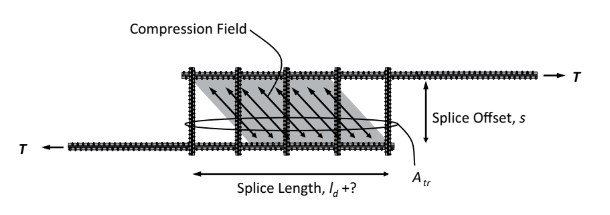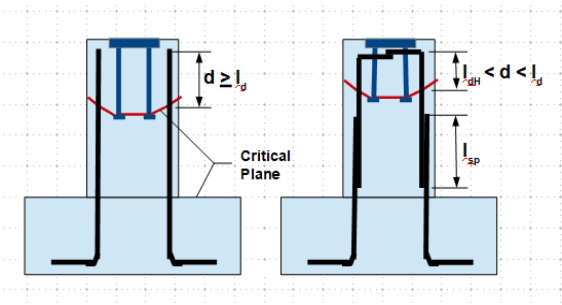CivilSigma
Structural
Hi everyone,
I am having a hard time understanding when to specify "development" or "splice length" in reinforced concrete design.
I understand that:
[ul]
[li]Development lengths are specified to prevent slippage failure, and transfer stress from reinforcement into concrete.[/li]
[li]Splice lengths are specified to prevent slippage between lapped reinforcement and transfer full stress across the bars.[/li]
[/ul]
I am trying to resist uplift forces in a pier cast ontop of slab using reinforcement (see sketch).
If we are analyzing the load path in tension (uplift):
[ol 1]
[li] Tension is resisted by the embed plate rods.[/li]
[li] Then force is resisted by the vertical pier reinforcement. [/li]
[li] Then force is resisted by dowels embeded into the slab.[/li]
[/ol]
Clause 12.1.1 of A23.3 says - "The calculated tension or compression in reinforcement at each section of reinforced concrete members shall be developed om each side of that section by embedment length, hook, or mechanical device, or by combination thereof. Hooks may be used in developing bars in tension only"
Doe that mean I need to specify development length of the reinforcement in the pier since it is considered a "section" other than the slab?
I am having a hard time understanding when to specify "development" or "splice length" in reinforced concrete design.
I understand that:
[ul]
[li]Development lengths are specified to prevent slippage failure, and transfer stress from reinforcement into concrete.[/li]
[li]Splice lengths are specified to prevent slippage between lapped reinforcement and transfer full stress across the bars.[/li]
[/ul]
I am trying to resist uplift forces in a pier cast ontop of slab using reinforcement (see sketch).
If we are analyzing the load path in tension (uplift):
[ol 1]
[li] Tension is resisted by the embed plate rods.[/li]
[li] Then force is resisted by the vertical pier reinforcement. [/li]
[li] Then force is resisted by dowels embeded into the slab.[/li]
[/ol]
Clause 12.1.1 of A23.3 says - "The calculated tension or compression in reinforcement at each section of reinforced concrete members shall be developed om each side of that section by embedment length, hook, or mechanical device, or by combination thereof. Hooks may be used in developing bars in tension only"
Doe that mean I need to specify development length of the reinforcement in the pier since it is considered a "section" other than the slab?


